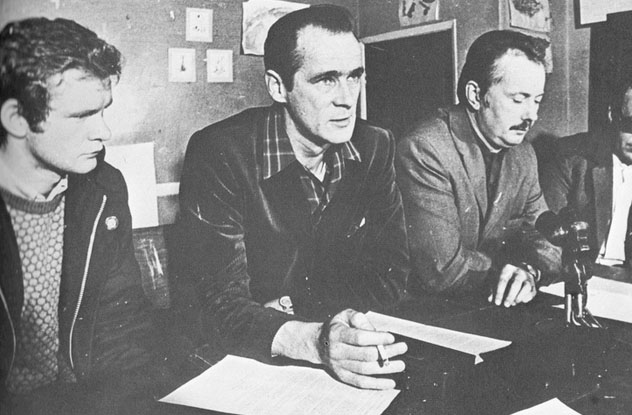 Weird Stuff
Weird Stuff  Weird Stuff
Weird Stuff  Our World
Our World 10 Ways Your Christmas Tree Is More Lit Than You Think
 Movies and TV
Movies and TV The 10 Coolest Stars to Set Sail on The Love Boat
 History
History 10 Things You Didn’t Know About the American National Anthem
 Technology
Technology Top 10 Everyday Tech Buzzwords That Hide a Darker Past
 Humans
Humans 10 Everyday Human Behaviors That Are Actually Survival Instincts
 Animals
Animals 10 Animals That Humiliated and Harmed Historical Leaders
 History
History 10 Most Influential Protests in Modern History
 Creepy
Creepy 10 More Representations of Death from Myth, Legend, and Folktale
 Technology
Technology 10 Scientific Breakthroughs of 2025 That’ll Change Everything
 Weird Stuff
Weird Stuff Ten Bizarre Facts About The Doge Meme
 Our World
Our World 10 Ways Your Christmas Tree Is More Lit Than You Think
 Movies and TV
Movies and TV The 10 Coolest Stars to Set Sail on The Love Boat
Who's Behind Listverse?

Jamie Frater
Head Editor
Jamie founded Listverse due to an insatiable desire to share fascinating, obscure, and bizarre facts. He has been a guest speaker on numerous national radio and television stations and is a five time published author.
More About Us History
History 10 Things You Didn’t Know About the American National Anthem
 Technology
Technology Top 10 Everyday Tech Buzzwords That Hide a Darker Past
 Humans
Humans 10 Everyday Human Behaviors That Are Actually Survival Instincts
 Animals
Animals 10 Animals That Humiliated and Harmed Historical Leaders
 History
History 10 Most Influential Protests in Modern History
 Creepy
Creepy 10 More Representations of Death from Myth, Legend, and Folktale
 Technology
Technology 10 Scientific Breakthroughs of 2025 That’ll Change Everything
10 Shockingly Daring Prison Escapes
From The Shawshank Redemption to Chicken Run, there have been dozens of films throughout the years that show the intricate planning and sheer bravado required to break out of prison. Unfortunately, many of the escapees in the real world are ruthless murderers and armed robbers, but that doesn’t make their daring escapes any less amazing.
10Richard Lee McNair Mailed Himself Out Of Prison

While robbing a grain elevator in 1987, Richard Lee McNair was caught by a worker who wasn’t supposed to be there. McNair whipped out a gun and wounded him, then ran outside and stumbled across another worker, who he shot dead. He was arrested hours later on charges of murder, attempted murder, and burglary. McNair was 29 at the time, but his real career was just beginning.
Immediately after his arrest, he greased up his handcuffs with lip balm and sprinted out of his North Dakota county jail. With officers hot on his tail, McNair took off on foot through the city of Minot, leading his pursuers on a high-speed foot race that ended with McNair falling out of a tree into the waiting arms of the law.
His next home was the North Dakota State Penitentiary, but the increased security was only a speed bump for McNair. In 1992, he crawled through a ventilation duct and went on the run for nine months.
McNair’s escapades got him moved into federal custody, and he wound up languishing in a series of maximum security prisons for over a decade. It wasn’t until 2006, a short while after being transferred to a penitentiary in Pollock, Louisiana, that McNair got another chance to escape, and this one went down in history. Part of McNair’s job at the Pollock prison was repairing torn mailbags, and over the course of months, he planned an escape that nobody would see coming—he was going to mail himself out.
On April 5, McNair seized his opportunity. He curled up in a handmade pod on a shipping pallet that was covered in old mailbags. The pallet was shrink-wrapped and taken to a nearby warehouse. McNair waited in the pod for hours, baking in the Louisiana heat and breathing through a thin cardboard tube that he’d shoved through the bottom of the pallet. When the warehouse guards left for lunch, McNair sliced his way to freedom and strolled out of the warehouse. He evaded recapture for over a year, despite several close encounters.
This dashboard camera video, shows him running verbal circles around an officer who was part of the statewide manhunt. The officer let him go.
9Michel Vaujour Broke Out With A Nectarine

For months, Nadine Vaujour had been taking private helicopter flying lessons. Her husband Michel was incarcerated in Paris’s La Sante Prison, a penitentiary reserved for hardened criminals, and Nadine was planning a daring, high-profile escape that would release Michel well before his 27-year sentence was up.
On May 26, 1986, the escape plan unfolded in front of hundreds of stunned inmates. Minutes before the helicopter arrived, Michel Vaujour forced his way past guards and onto the prison roof using a fake gun and a nectarine painted to look like a grenade.
Nadine showed up in the helicopter as planned, flying low over the roof while a gunman leaped out and opened fire on the approaching guards. Michel hoisted himself onto one of the helicopter’s skids, followed by the gunman, and the trio took to the skies as the prison guards fired helplessly at the receding helicopter. Minutes later, they touched down in a nearby soccer field and clambered into a waiting car.
A few months later, Michel Vaujour surfaced again during a botched bank robbery. He was shot in the head and taken to the hospital. Afterward, he went on to serve the remainder of his sentence. He was released in 2003 after serving a total of 27 years in prison, 17 of which were spent in solitary confinement.
8Cecil Molle Feez Tunneled Through A German POW Camp

While most escape stories involve criminals breaking out after being rightfully incarcerated, in the most inspirational ones, prisoners of war escape harsh detention camps.
On March 28, 1918, Lieutenant Cecil Molle Feez was captured by a German patrol after his plane went down behind enemy lines. He landed in the Landshut POW camp in Bavaria and soon began collaborating with a fellow inmate, Lieutenant Oscar Thomas Flight. Their plan would be dangerous but simple: They were going to tunnel out.
For nearly half a year, the two prisoners painstakingly scraped their way beneath the camp, picking at the dirt with forks and spoons. To get far enough past the fence, the tunnel had to be 30 meters (100 ft) long, which meant disposing of a lot of dirt. The two men took turns filling their pockets with loose soil then strolling to let it sift through holes in their pockets and down their pant legs. As summer turned into fall, the tunnel came tantalizingly close to completion.
Unfortunately, this story has no happy ending. On September 8, German soldiers stormed the camp and informed the prisoners that they were doing an inspection—and they only searched Flight’s room. Someone must have talked. The tunnel was found, and Feez and Flight were shoved into an isolation tank for 11 days. They spent the rest of the war in Landshut.
7James Rodney Leonard Hitched A Helicopter Ride

In 1985, 20-year-old James Rodney Leonard was serving a life sentence for murder in a South Carolina penitentiary. The maximum security prison was supposed to be escape-proof, but Leonard didn’t play by the rules.
On December 19, a young woman named Joyce Mattox chartered a helicopter at a nearby airstrip. As it lifted into the air, Mattox pulled a handgun out of her purse and forced the pilot to fly to the prison. Back in the prison yard, 200 inmates were out for their daily exercise. As the helicopter approached, five of them broke out of the crowd and ran to the chopper.
But there was a problem—the small aircraft was only designed to hold three people. So Leonard roughly shoved two of the other prisoners to the ground and climbed in along with Jesse Smith and William Ballew, both of whom were doing time for armed robbery.
Still overloaded with five passengers, the pilot did his best to take off. By then, the guards had declared open season on the chopper, and a hail of bullets was heading their way. Mattox returned fire, but their only chance was making it out of the prison yard.
As bullets zinged off the metal frame, the tiny Hughes 300-C struggled through its treacherous climb to 3.5 meters (12 ft)—the height of the prison fence. The skids practically scraped barbed wire as the helicopter went over, and the three escapees tasted freedom. But they were quickly picked up and sentenced to kidnapping, air piracy, assault, and conspiracy in addition to their previous sentences.
6Airey Neave Impersonated A Nazi Soldier

Colditz Castle is a literal fortress, a bastion in the heart of Germany built on the edge of a sheer 75-meter (250 ft) cliff. Its walls are 2 meters (7 ft) thick, and during World War II, it was 650 kilometers (400 mi) from anything not under the shadow of a swastika. This was where British officer Airey Neave found himself imprisoned in 1941.
Colditz Castle was a relatively pleasant place for a Nazi prison camp. It was an officers’ prison, and the inmates were treated with a modicum of respect. But a golden prison is still a prison, and Neave decided to escape. It had never been done before, and Neave wasn’t immediately successful. His first escape attempt was on August 28, 1941—he whipped up a makeshift German uniform using green scenery paint and tried to simply walk out. The second a searchlight landed on him, the bright green paint stood out clearly.
Five months later, Neave tried again. This time, he had an accomplice—a fellow prisoner—and the two once again donned fake German uniforms. Instead of walking out the front door, though, they crawled through the ceiling and came out in a guard house near the fortress’s perimeter.
On foot and by train, they then traveled nearly 650 kilometers (400 mi) southeast across Germany, sleeping where they could and evading search parties the whole way. They crawled across the Swiss border then made their way through France and Spain, finally setting foot on British soil nearly four months after leaving their prison.
5Seamus Twomey’s IRA Rescue Squad

As the chief of staff for the Provisional IRA, Seamus Twomey was not a very nice guy. He joined the paramilitary group in the ’30s, and by the early ’70s, he was the commanding officer of their Belfast Brigade. On July 21, 1972, the Brigade detonated 19 bombs throughout the city, injuring 130 people and killing 11—all designs set in motion by Twomey.
His violent machinations caught up with him, and he was arrested in 1973. After he was convicted, Twomey was trucked off to Mountjoy Prison, Ireland’s largest penitentiary. But the IRA isn’t known for letting their officers rot in a cell—the same month he was incarcerated, the prison descended into turmoil when a hijacked helicopter roared into the exercise yard. Seconds later, it was airborne again with Twomey safely aboard.
A month later, Twomey returned to prison, captured during a high-speed chase in Dublin.
4475 Taliban Escaped From An Afghan Prison
We’ve covered mass prison breaks before, but few of them compare to the sheer scale of the 2011 Sarposa Prison escape in Kandahar, Afghanistan.
Sarposa Prison is reserved almost entirely for high-risk criminals, such as Taliban militants. In April 2011, the massive prison held over 500 Taliban prisoners within its walls. It’s supposed to be one of the most secure prisons in the country, but that claim proved less that solid when around 475 prisoners escaped through a massive tunnel under the prison walls.
The entire underground structure was over 100 meters (328 ft) long and was equipped with concrete shoring, electricity, and ventilation shafts. Like many of these stories, the real work came from outside the prison. Work on the tunnel began months before the breakout in a small rented house nearby.
Early in the morning on April 25, the tunnel broke through the prison floor, and hundreds of Taliban dropped through one-by-one, a process that took hours. Only about 40 of the prisoners have since been found.
3Nabetari Drifted At Sea For Seven Months

As part of their Pacific campaign during World War II, Japanese forces took over dozens of small islands. One of these was a tiny rock called Ocean Island (or Banaba Island), and it kick-started one of the most incredible survival stories to come out of the war.
Originally from the island of Nikunau, Nabetari was 22 years old when he traveled to Ocean Island to work in the phosphate mines in 1942. He had no idea the island lay directly in the path of the Japanese war machine. Soon enough, Japanese troops landed on the island and shipped most of the workers and inhabitants to various mainland camps. They selected about 100 people to stay and work on the island to provide them with food, choosing Nabetari because he was a skilled fisherman. The island became a large, isolated prison.
Over time, the Japanese troops figured out how to fish and run the farms on their own, at which point they ordered the workers to start digging their own graves. Under the dead of night, Nabetari and five other young men made their escape—they piled into three tiny canoes and set out for the Gilbert Islands, nearly 400 kilometers (250 mi) away.
The first night, one of the canoes drifted out of sight; its occupants were never heard from again. Later, the second canoe disappeared, and a week after that, Nabetari’s canoe capsized in the night. Helplessly, he watched his mate drown. Nabetari then righted the canoe and climbed aboard.
For the next seven months, Nabetari drifted across the open ocean, alone except for the fish. He ate what he could catch, and he drank when it rained. Eventually, the canoe washed ashore on Ninigo Island—2,400 kilometers (1,500 mi) from Ocean Island.
Nabetari collapsed in the sand and crawled along the waterline until several locals spotted his emaciated form struggling in the surf. He made a complete recovery.
2Andre Devigny Escaped A Gestapo Fortress

When Nazi Germany occupied France in 1940, a former schoolteacher turned infantryman went underground with the Resistance. That man was Andre Devigny, and he served as a liaison to the British Special Operations Executive before joining a network that helped refugees get across the border into Switzerland.
In April 1943, a Nazi mole in the network got Devigny arrested by the Gestapo. Devigny was sent to Montluc Prison—hell on Earth for anti-Nazi freedom fighters. He was personally tortured by Klaus Barbie, one of the most brutal men to ever walk on two legs. For four months, Devigny was kept handcuffed in a small, dark cell in between macabre torture sessions at Barbie’s hands. On August 20, Barbie told Devigny that he would be executed in a few days. Luckily, Devigny hadn’t been idle.
He’d learned early on that he could pick his handcuffs with a safety pin, and he’d planned an escape route by lifting his cell’s wooden floorboards with a concrete-sharpened spoon. He and a fellow inmate escaped at night, killing a guard as they left their cells. Then they took a makeshift grappling hook, made from twisted bed sheets and a lamp, and swung across a 4.5-meter (15 ft) gap to freedom.
After making it to Switzerland, Devigny immediately rejoined the Resistance and was right beside the Allied foot soldiers when they took back southern France in 1944.
1Bud Day Spent Five Years In A North Vietnamese Prison Camp

The Vietnam War was long, brutal, and—according to many—completely unnecessary. But whatever the reasons for going into the conflict, the men and women on the ground often displayed amazing perseverance. In August 1967, Major Bud Day was flying over North Vietnam when his plane was shot down. Seeing his parachute, the North Vietnamese already had their guns drawn when he landed.
He endured several days of torture, and on his fifth day in the prison camp, Day made his escape. He wriggled out of the ropes that bound his hands and took off into the unforgiving jungle. He had broken his arm in the plane crash and was blind in one eye, but he stumbled doggedly onward, hiding in the mud—sometimes for hours—whenever a Vietnamese patrol came too close.
For days, he pressed on, eating berries and live frogs to survive. After more than two weeks, he had made it to within a few miles of a US army base when a Viet Cong patrol stumbled across him and shot him in the leg.
This time, there was no escape. For the next five and a half years, Bud Day survived torture at the hands of the North Vietnamese as they moved him among dozens of different prisons. At one point, he shared a cell with future Senator John McCain. Day was released in 1973 and lived to the ripe old age of 88.








